Business Operations: Accounting, HR, Team Dynamics, Customer Service
VerifiedAdded on 2022/12/19
|10
|2060
|72
Report
AI Summary
This report provides a detailed analysis of how businesses operate, covering key areas such as the business environment, accounting, and human resources. It explores the importance of accounting for business success, outlining its role in maintaining records, facilitating decision-making, and meeting legal requirements. The report also describes the different functions of the HR department, including planning, recruitment, and performance management. Furthermore, it delves into the stages of team development, motivation theories, and leadership styles, offering insights into effective team management. The report also provides an interpretation of a profit and loss account and touches upon customer service principles, providing a comprehensive overview of essential business functions. The report concludes with a summary of the findings and a list of references.
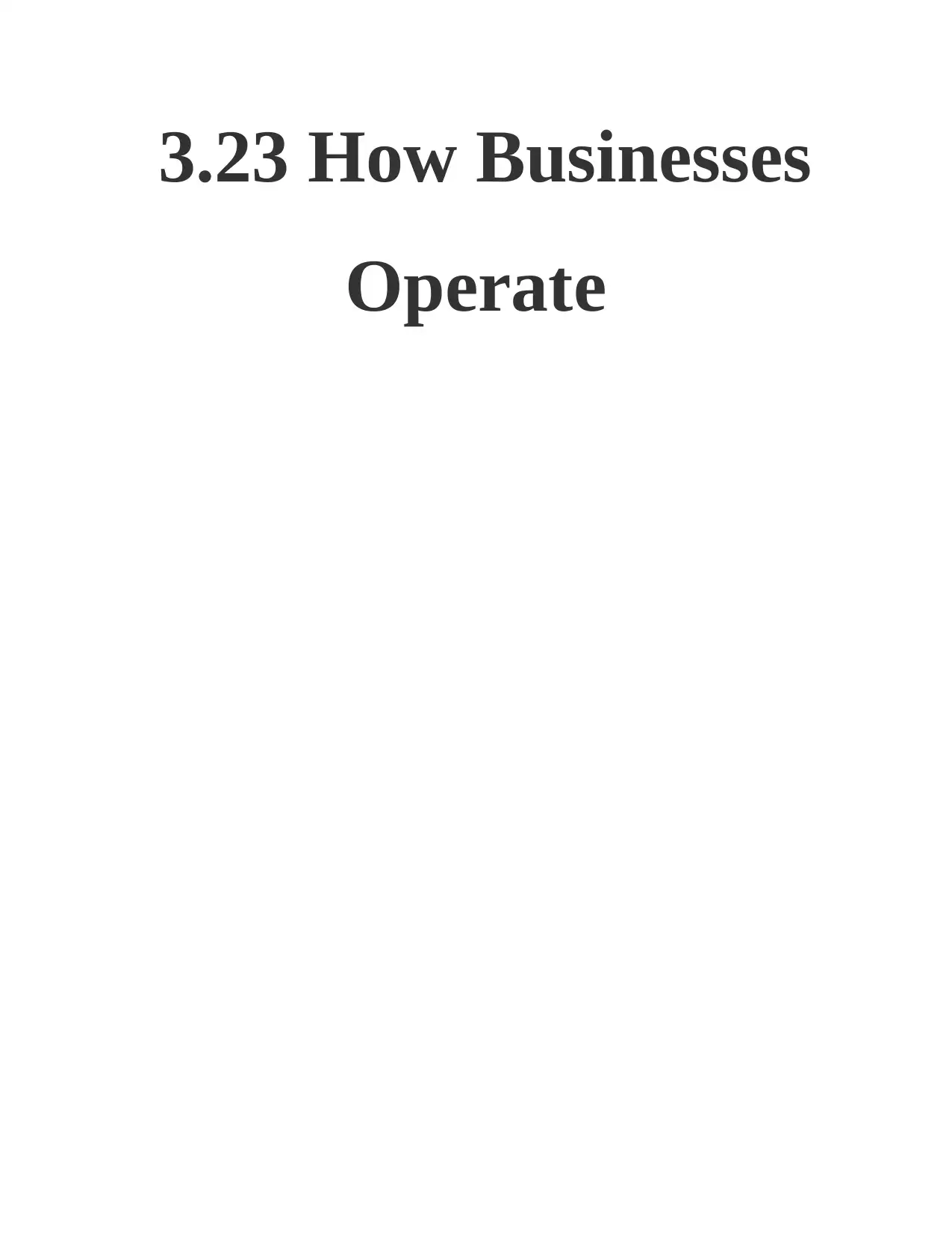
3.23 How Businesses
Operate
Operate
Paraphrase This Document
Need a fresh take? Get an instant paraphrase of this document with our AI Paraphraser
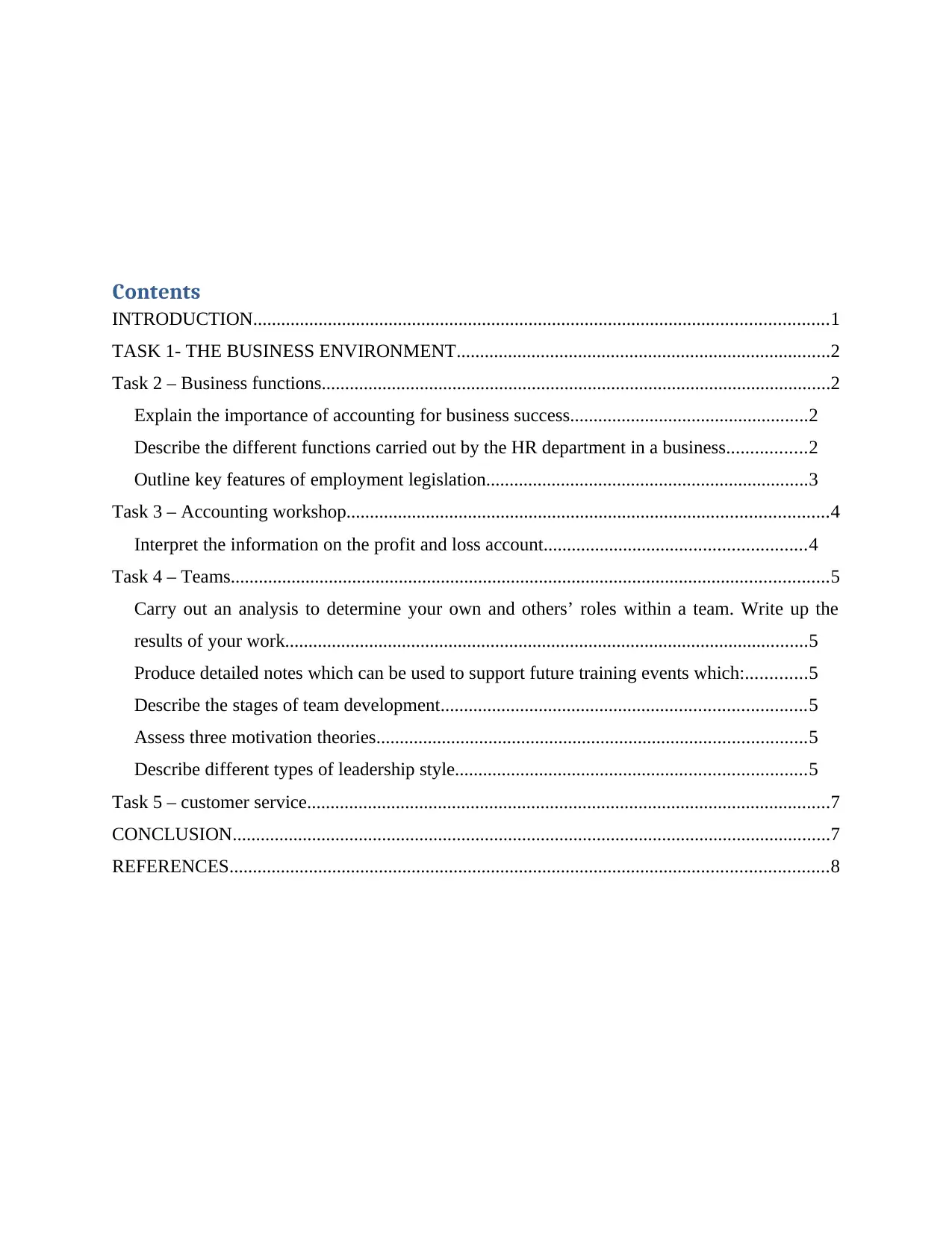
Contents
INTRODUCTION...........................................................................................................................1
TASK 1- THE BUSINESS ENVIRONMENT................................................................................2
Task 2 – Business functions.............................................................................................................2
Explain the importance of accounting for business success...................................................2
Describe the different functions carried out by the HR department in a business.................2
Outline key features of employment legislation.....................................................................3
Task 3 – Accounting workshop.......................................................................................................4
Interpret the information on the profit and loss account........................................................4
Task 4 – Teams................................................................................................................................5
Carry out an analysis to determine your own and others’ roles within a team. Write up the
results of your work................................................................................................................5
Produce detailed notes which can be used to support future training events which:.............5
Describe the stages of team development..............................................................................5
Assess three motivation theories............................................................................................5
Describe different types of leadership style...........................................................................5
Task 5 – customer service................................................................................................................7
CONCLUSION................................................................................................................................7
REFERENCES................................................................................................................................8
INTRODUCTION...........................................................................................................................1
TASK 1- THE BUSINESS ENVIRONMENT................................................................................2
Task 2 – Business functions.............................................................................................................2
Explain the importance of accounting for business success...................................................2
Describe the different functions carried out by the HR department in a business.................2
Outline key features of employment legislation.....................................................................3
Task 3 – Accounting workshop.......................................................................................................4
Interpret the information on the profit and loss account........................................................4
Task 4 – Teams................................................................................................................................5
Carry out an analysis to determine your own and others’ roles within a team. Write up the
results of your work................................................................................................................5
Produce detailed notes which can be used to support future training events which:.............5
Describe the stages of team development..............................................................................5
Assess three motivation theories............................................................................................5
Describe different types of leadership style...........................................................................5
Task 5 – customer service................................................................................................................7
CONCLUSION................................................................................................................................7
REFERENCES................................................................................................................................8
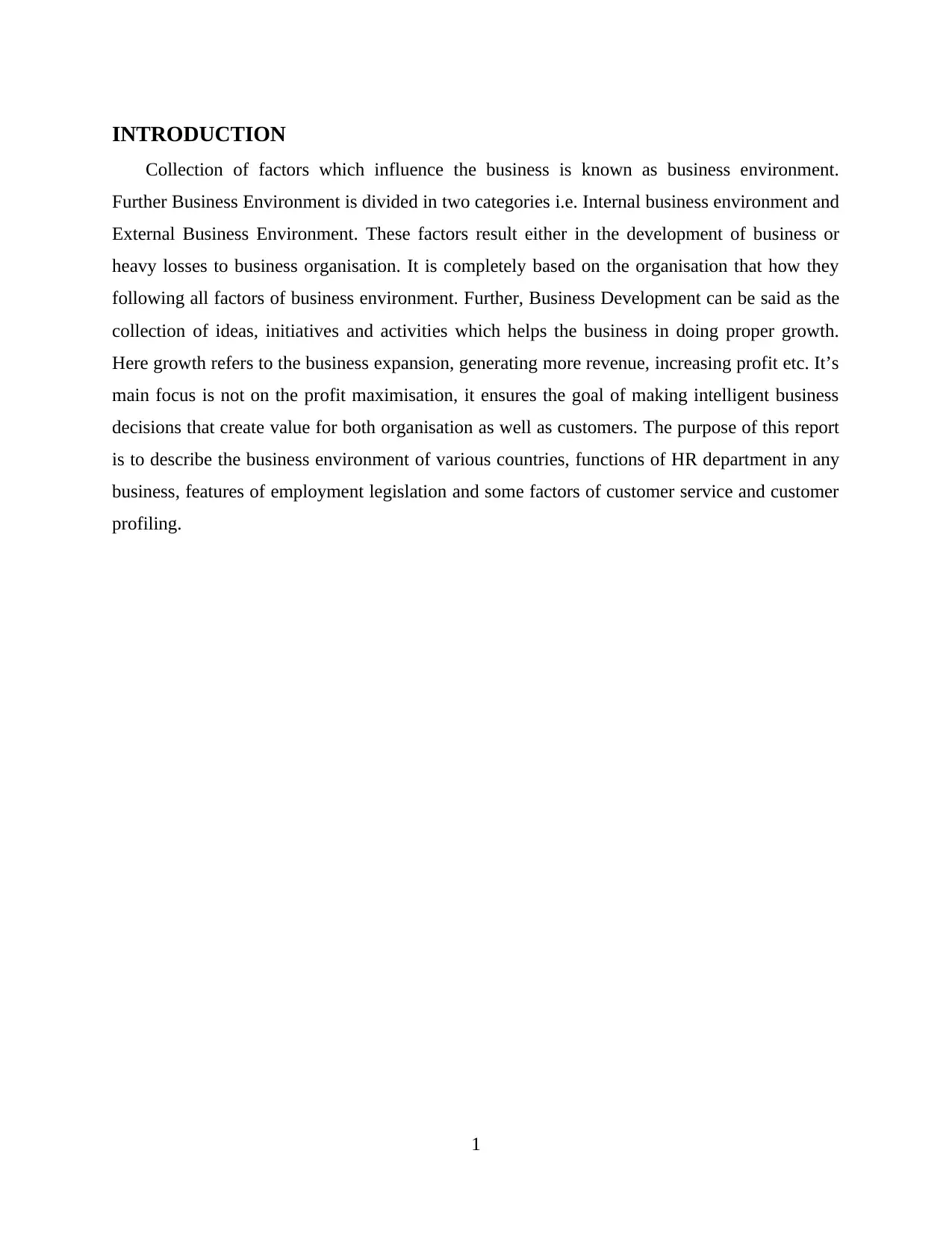
INTRODUCTION
Collection of factors which influence the business is known as business environment.
Further Business Environment is divided in two categories i.e. Internal business environment and
External Business Environment. These factors result either in the development of business or
heavy losses to business organisation. It is completely based on the organisation that how they
following all factors of business environment. Further, Business Development can be said as the
collection of ideas, initiatives and activities which helps the business in doing proper growth.
Here growth refers to the business expansion, generating more revenue, increasing profit etc. It’s
main focus is not on the profit maximisation, it ensures the goal of making intelligent business
decisions that create value for both organisation as well as customers. The purpose of this report
is to describe the business environment of various countries, functions of HR department in any
business, features of employment legislation and some factors of customer service and customer
profiling.
1
Collection of factors which influence the business is known as business environment.
Further Business Environment is divided in two categories i.e. Internal business environment and
External Business Environment. These factors result either in the development of business or
heavy losses to business organisation. It is completely based on the organisation that how they
following all factors of business environment. Further, Business Development can be said as the
collection of ideas, initiatives and activities which helps the business in doing proper growth.
Here growth refers to the business expansion, generating more revenue, increasing profit etc. It’s
main focus is not on the profit maximisation, it ensures the goal of making intelligent business
decisions that create value for both organisation as well as customers. The purpose of this report
is to describe the business environment of various countries, functions of HR department in any
business, features of employment legislation and some factors of customer service and customer
profiling.
1
⊘ This is a preview!⊘
Do you want full access?
Subscribe today to unlock all pages.

Trusted by 1+ million students worldwide
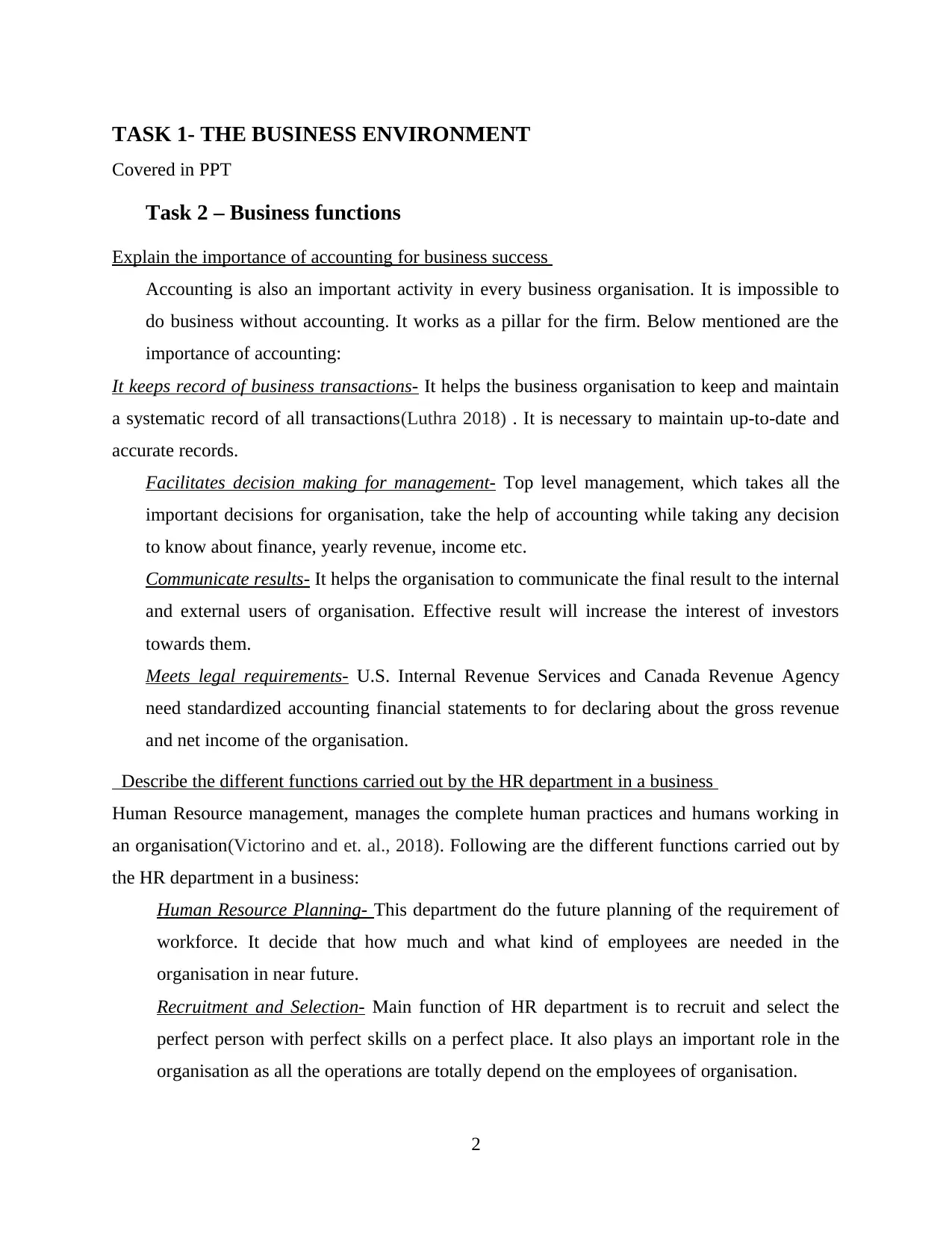
TASK 1- THE BUSINESS ENVIRONMENT
Covered in PPT
Task 2 – Business functions
Explain the importance of accounting for business success
Accounting is also an important activity in every business organisation. It is impossible to
do business without accounting. It works as a pillar for the firm. Below mentioned are the
importance of accounting:
It keeps record of business transactions- It helps the business organisation to keep and maintain
a systematic record of all transactions(Luthra 2018) . It is necessary to maintain up-to-date and
accurate records.
Facilitates decision making for management- Top level management, which takes all the
important decisions for organisation, take the help of accounting while taking any decision
to know about finance, yearly revenue, income etc.
Communicate results- It helps the organisation to communicate the final result to the internal
and external users of organisation. Effective result will increase the interest of investors
towards them.
Meets legal requirements- U.S. Internal Revenue Services and Canada Revenue Agency
need standardized accounting financial statements to for declaring about the gross revenue
and net income of the organisation.
Describe the different functions carried out by the HR department in a business
Human Resource management, manages the complete human practices and humans working in
an organisation(Victorino and et. al., 2018). Following are the different functions carried out by
the HR department in a business:
Human Resource Planning- This department do the future planning of the requirement of
workforce. It decide that how much and what kind of employees are needed in the
organisation in near future.
Recruitment and Selection- Main function of HR department is to recruit and select the
perfect person with perfect skills on a perfect place. It also plays an important role in the
organisation as all the operations are totally depend on the employees of organisation.
2
Covered in PPT
Task 2 – Business functions
Explain the importance of accounting for business success
Accounting is also an important activity in every business organisation. It is impossible to
do business without accounting. It works as a pillar for the firm. Below mentioned are the
importance of accounting:
It keeps record of business transactions- It helps the business organisation to keep and maintain
a systematic record of all transactions(Luthra 2018) . It is necessary to maintain up-to-date and
accurate records.
Facilitates decision making for management- Top level management, which takes all the
important decisions for organisation, take the help of accounting while taking any decision
to know about finance, yearly revenue, income etc.
Communicate results- It helps the organisation to communicate the final result to the internal
and external users of organisation. Effective result will increase the interest of investors
towards them.
Meets legal requirements- U.S. Internal Revenue Services and Canada Revenue Agency
need standardized accounting financial statements to for declaring about the gross revenue
and net income of the organisation.
Describe the different functions carried out by the HR department in a business
Human Resource management, manages the complete human practices and humans working in
an organisation(Victorino and et. al., 2018). Following are the different functions carried out by
the HR department in a business:
Human Resource Planning- This department do the future planning of the requirement of
workforce. It decide that how much and what kind of employees are needed in the
organisation in near future.
Recruitment and Selection- Main function of HR department is to recruit and select the
perfect person with perfect skills on a perfect place. It also plays an important role in the
organisation as all the operations are totally depend on the employees of organisation.
2
Paraphrase This Document
Need a fresh take? Get an instant paraphrase of this document with our AI Paraphraser
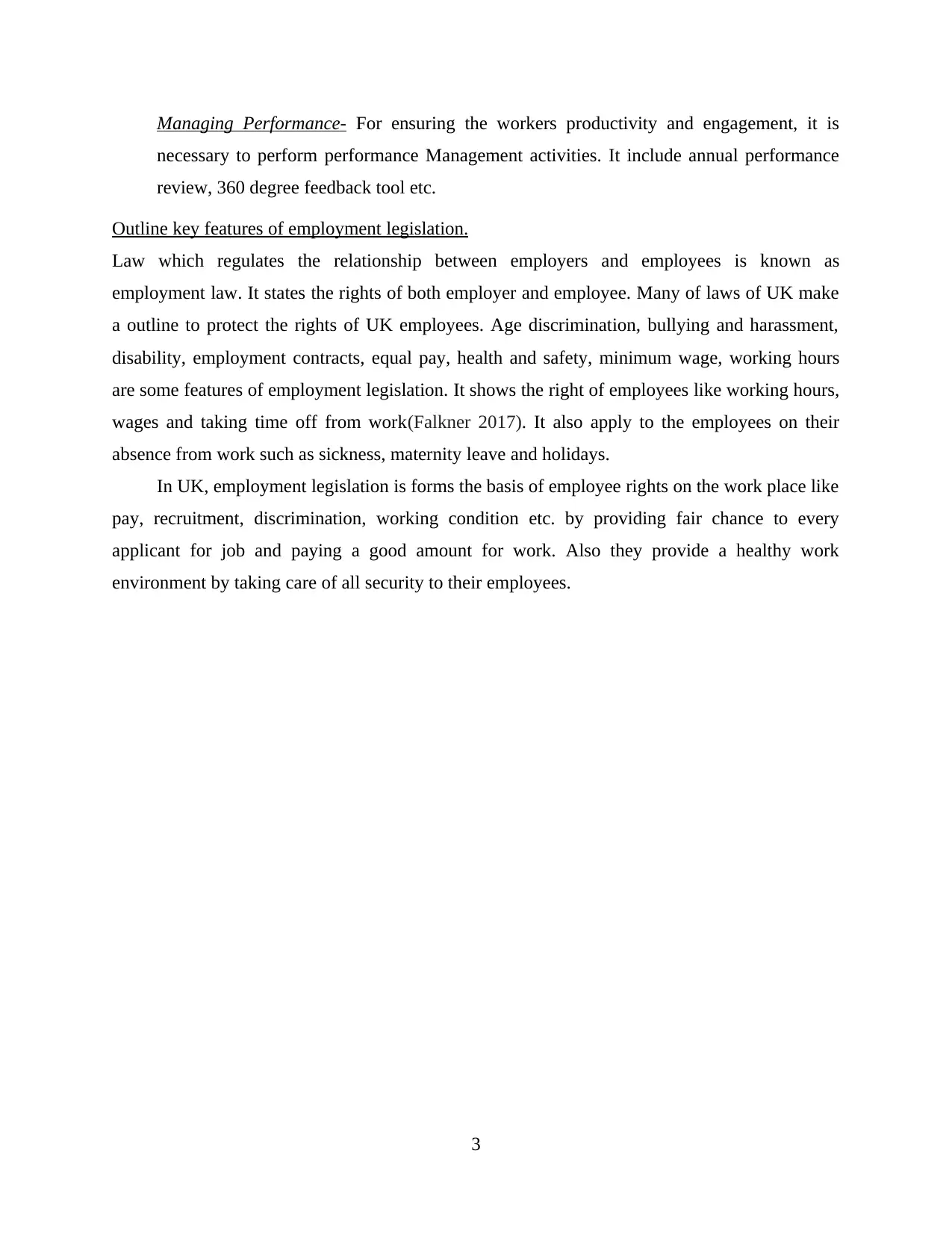
Managing Performance- For ensuring the workers productivity and engagement, it is
necessary to perform performance Management activities. It include annual performance
review, 360 degree feedback tool etc.
Outline key features of employment legislation.
Law which regulates the relationship between employers and employees is known as
employment law. It states the rights of both employer and employee. Many of laws of UK make
a outline to protect the rights of UK employees. Age discrimination, bullying and harassment,
disability, employment contracts, equal pay, health and safety, minimum wage, working hours
are some features of employment legislation. It shows the right of employees like working hours,
wages and taking time off from work(Falkner 2017). It also apply to the employees on their
absence from work such as sickness, maternity leave and holidays.
In UK, employment legislation is forms the basis of employee rights on the work place like
pay, recruitment, discrimination, working condition etc. by providing fair chance to every
applicant for job and paying a good amount for work. Also they provide a healthy work
environment by taking care of all security to their employees.
3
necessary to perform performance Management activities. It include annual performance
review, 360 degree feedback tool etc.
Outline key features of employment legislation.
Law which regulates the relationship between employers and employees is known as
employment law. It states the rights of both employer and employee. Many of laws of UK make
a outline to protect the rights of UK employees. Age discrimination, bullying and harassment,
disability, employment contracts, equal pay, health and safety, minimum wage, working hours
are some features of employment legislation. It shows the right of employees like working hours,
wages and taking time off from work(Falkner 2017). It also apply to the employees on their
absence from work such as sickness, maternity leave and holidays.
In UK, employment legislation is forms the basis of employee rights on the work place like
pay, recruitment, discrimination, working condition etc. by providing fair chance to every
applicant for job and paying a good amount for work. Also they provide a healthy work
environment by taking care of all security to their employees.
3
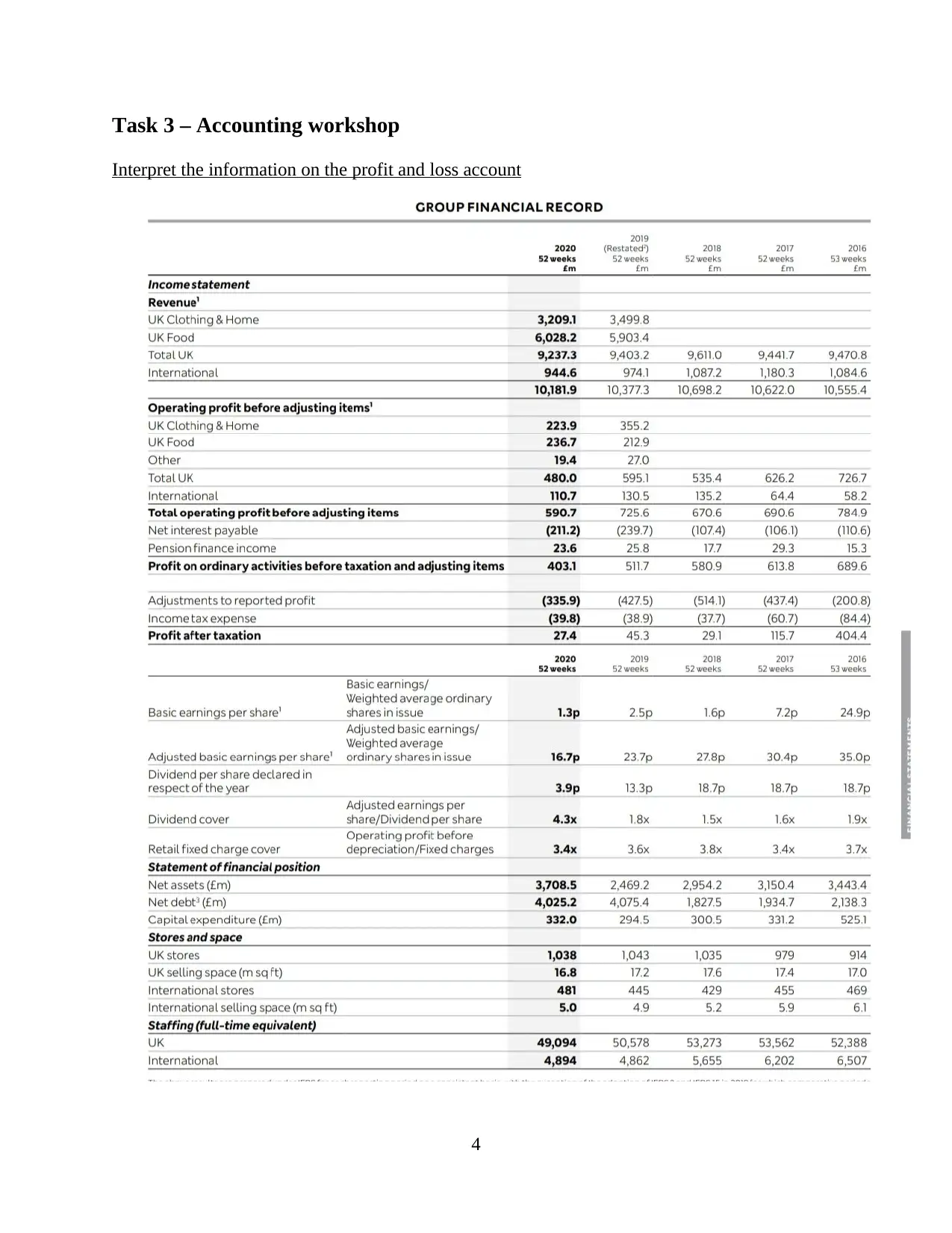
Task 3 – Accounting workshop
Interpret the information on the profit and loss account
4
Interpret the information on the profit and loss account
4
⊘ This is a preview!⊘
Do you want full access?
Subscribe today to unlock all pages.

Trusted by 1+ million students worldwide
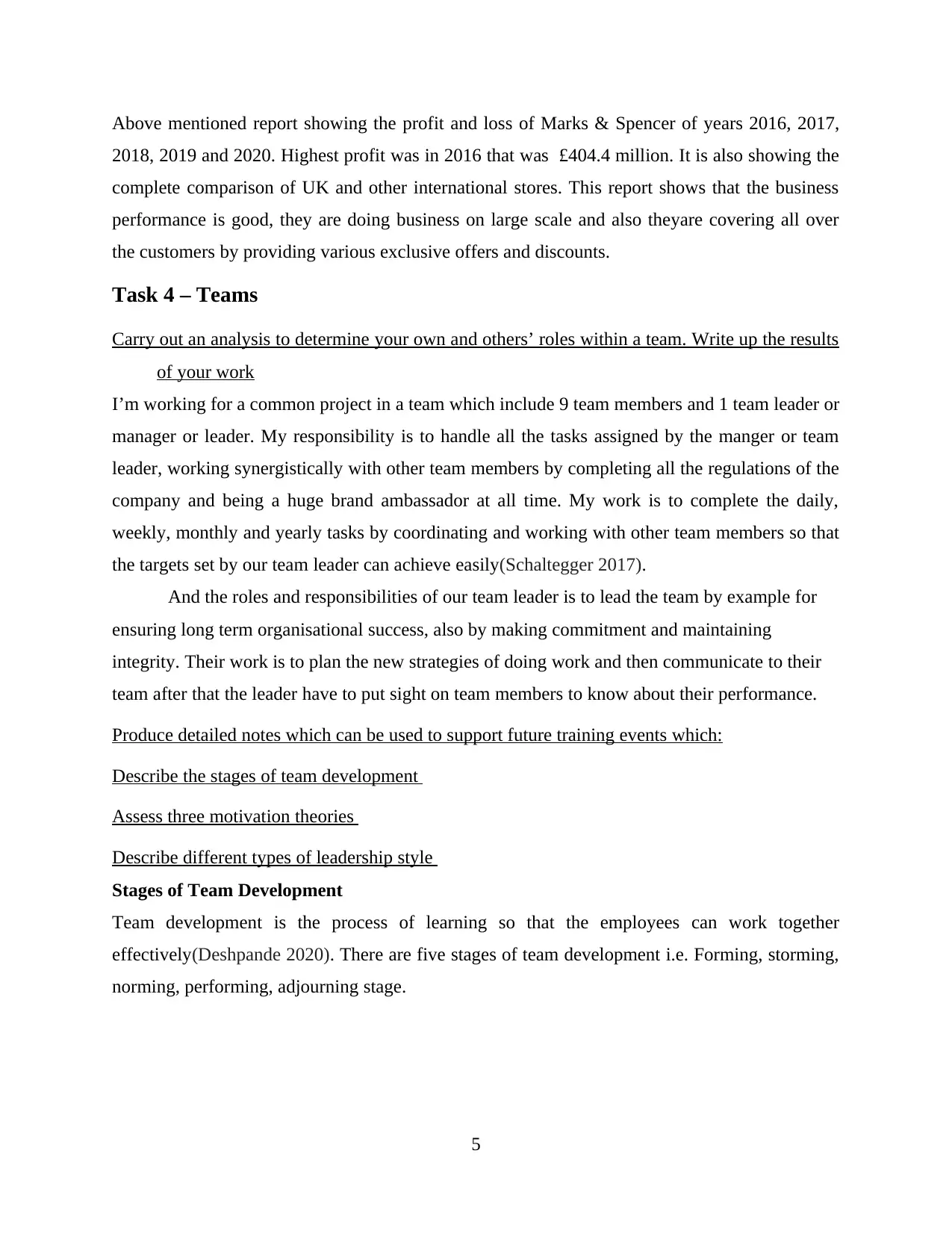
Above mentioned report showing the profit and loss of Marks & Spencer of years 2016, 2017,
2018, 2019 and 2020. Highest profit was in 2016 that was £404.4 million. It is also showing the
complete comparison of UK and other international stores. This report shows that the business
performance is good, they are doing business on large scale and also theyare covering all over
the customers by providing various exclusive offers and discounts.
Task 4 – Teams
Carry out an analysis to determine your own and others’ roles within a team. Write up the results
of your work
I’m working for a common project in a team which include 9 team members and 1 team leader or
manager or leader. My responsibility is to handle all the tasks assigned by the manger or team
leader, working synergistically with other team members by completing all the regulations of the
company and being a huge brand ambassador at all time. My work is to complete the daily,
weekly, monthly and yearly tasks by coordinating and working with other team members so that
the targets set by our team leader can achieve easily(Schaltegger 2017).
And the roles and responsibilities of our team leader is to lead the team by example for
ensuring long term organisational success, also by making commitment and maintaining
integrity. Their work is to plan the new strategies of doing work and then communicate to their
team after that the leader have to put sight on team members to know about their performance.
Produce detailed notes which can be used to support future training events which:
Describe the stages of team development
Assess three motivation theories
Describe different types of leadership style
Stages of Team Development
Team development is the process of learning so that the employees can work together
effectively(Deshpande 2020). There are five stages of team development i.e. Forming, storming,
norming, performing, adjourning stage.
5
2018, 2019 and 2020. Highest profit was in 2016 that was £404.4 million. It is also showing the
complete comparison of UK and other international stores. This report shows that the business
performance is good, they are doing business on large scale and also theyare covering all over
the customers by providing various exclusive offers and discounts.
Task 4 – Teams
Carry out an analysis to determine your own and others’ roles within a team. Write up the results
of your work
I’m working for a common project in a team which include 9 team members and 1 team leader or
manager or leader. My responsibility is to handle all the tasks assigned by the manger or team
leader, working synergistically with other team members by completing all the regulations of the
company and being a huge brand ambassador at all time. My work is to complete the daily,
weekly, monthly and yearly tasks by coordinating and working with other team members so that
the targets set by our team leader can achieve easily(Schaltegger 2017).
And the roles and responsibilities of our team leader is to lead the team by example for
ensuring long term organisational success, also by making commitment and maintaining
integrity. Their work is to plan the new strategies of doing work and then communicate to their
team after that the leader have to put sight on team members to know about their performance.
Produce detailed notes which can be used to support future training events which:
Describe the stages of team development
Assess three motivation theories
Describe different types of leadership style
Stages of Team Development
Team development is the process of learning so that the employees can work together
effectively(Deshpande 2020). There are five stages of team development i.e. Forming, storming,
norming, performing, adjourning stage.
5
Paraphrase This Document
Need a fresh take? Get an instant paraphrase of this document with our AI Paraphraser
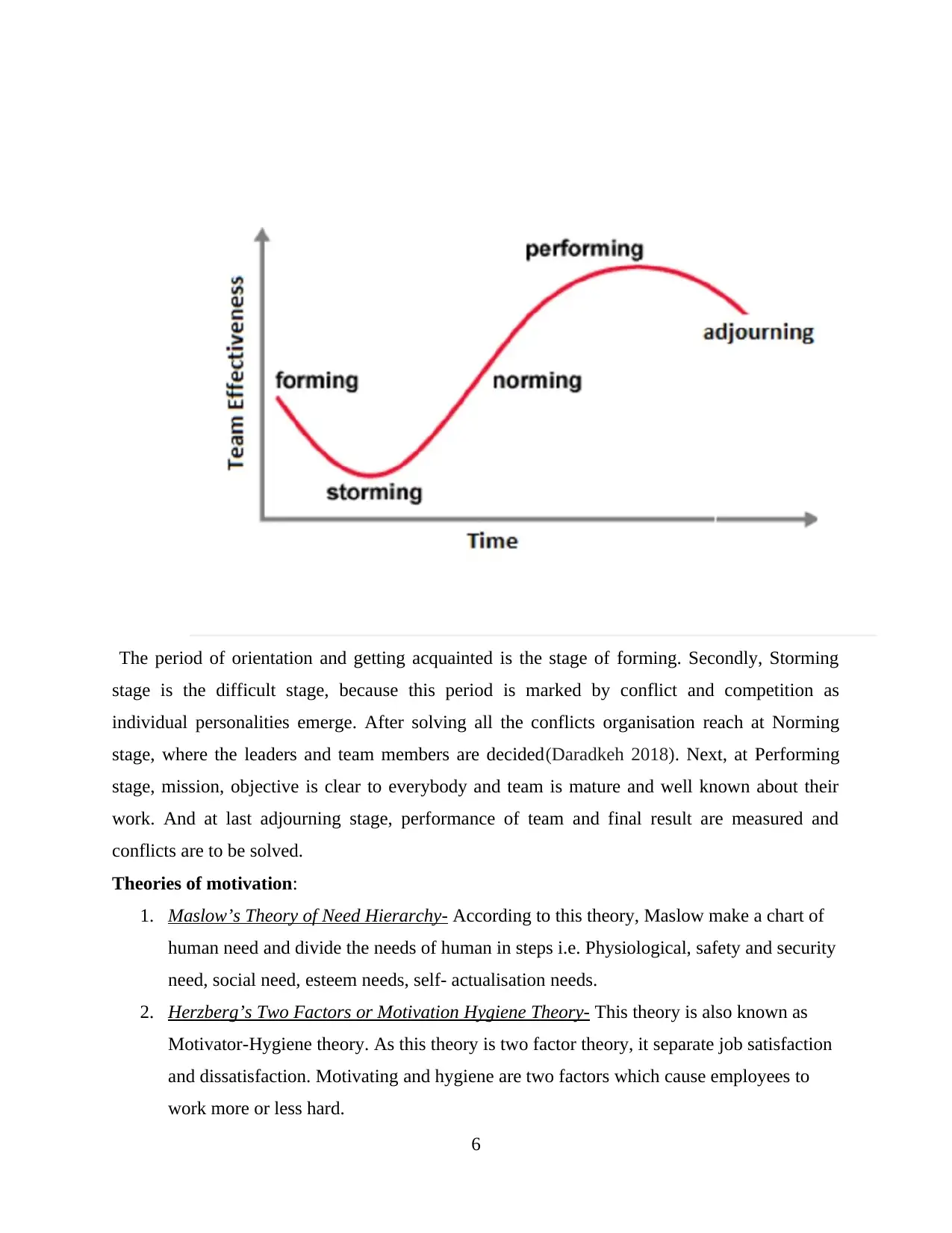
The period of orientation and getting acquainted is the stage of forming. Secondly, Storming
stage is the difficult stage, because this period is marked by conflict and competition as
individual personalities emerge. After solving all the conflicts organisation reach at Norming
stage, where the leaders and team members are decided(Daradkeh 2018). Next, at Performing
stage, mission, objective is clear to everybody and team is mature and well known about their
work. And at last adjourning stage, performance of team and final result are measured and
conflicts are to be solved.
Theories of motivation:
1. Maslow’s Theory of Need Hierarchy- According to this theory, Maslow make a chart of
human need and divide the needs of human in steps i.e. Physiological, safety and security
need, social need, esteem needs, self- actualisation needs.
2. Herzberg’s Two Factors or Motivation Hygiene Theory- This theory is also known as
Motivator-Hygiene theory. As this theory is two factor theory, it separate job satisfaction
and dissatisfaction. Motivating and hygiene are two factors which cause employees to
work more or less hard.
6
stage is the difficult stage, because this period is marked by conflict and competition as
individual personalities emerge. After solving all the conflicts organisation reach at Norming
stage, where the leaders and team members are decided(Daradkeh 2018). Next, at Performing
stage, mission, objective is clear to everybody and team is mature and well known about their
work. And at last adjourning stage, performance of team and final result are measured and
conflicts are to be solved.
Theories of motivation:
1. Maslow’s Theory of Need Hierarchy- According to this theory, Maslow make a chart of
human need and divide the needs of human in steps i.e. Physiological, safety and security
need, social need, esteem needs, self- actualisation needs.
2. Herzberg’s Two Factors or Motivation Hygiene Theory- This theory is also known as
Motivator-Hygiene theory. As this theory is two factor theory, it separate job satisfaction
and dissatisfaction. Motivating and hygiene are two factors which cause employees to
work more or less hard.
6
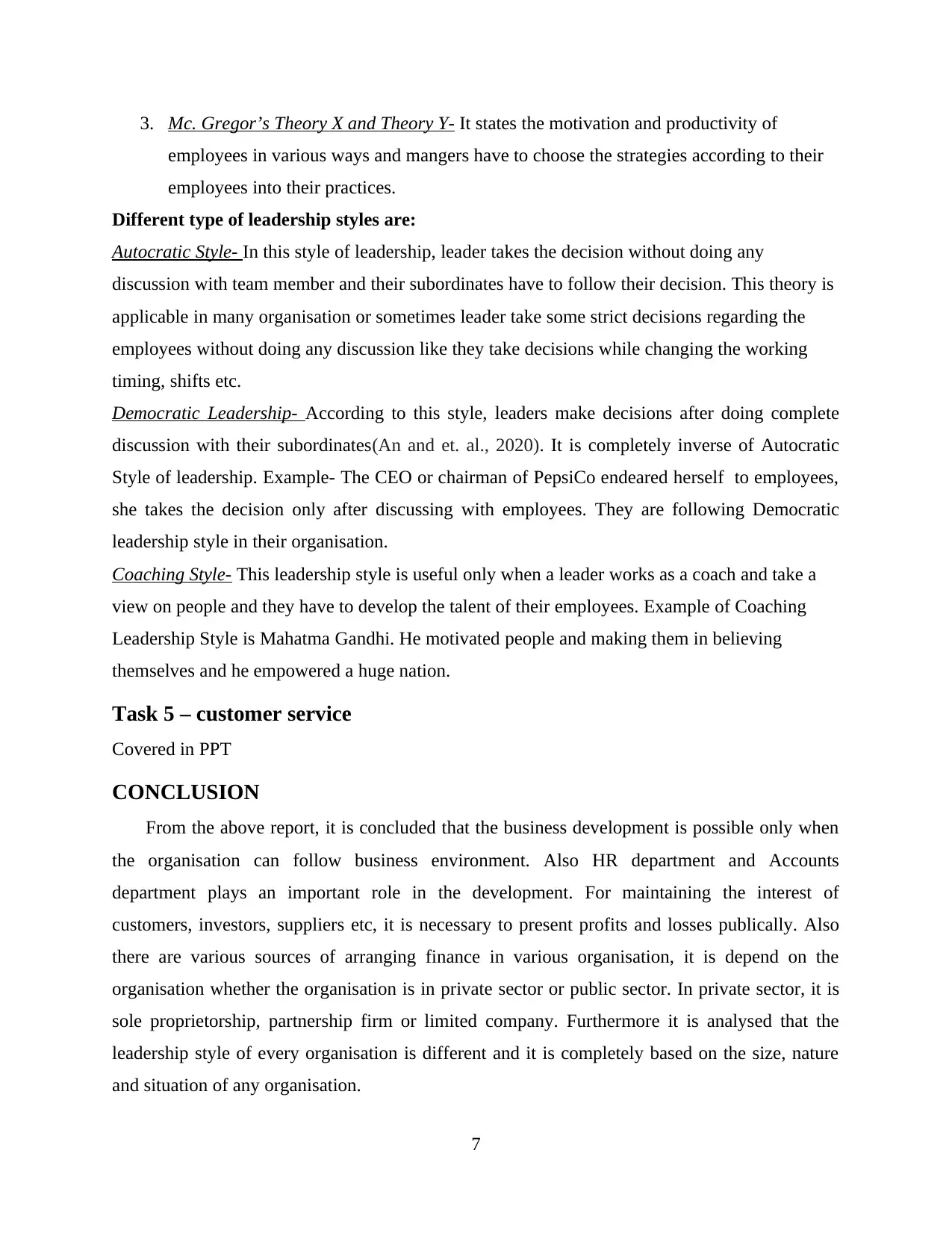
3. Mc. Gregor’s Theory X and Theory Y- It states the motivation and productivity of
employees in various ways and mangers have to choose the strategies according to their
employees into their practices.
Different type of leadership styles are:
Autocratic Style- In this style of leadership, leader takes the decision without doing any
discussion with team member and their subordinates have to follow their decision. This theory is
applicable in many organisation or sometimes leader take some strict decisions regarding the
employees without doing any discussion like they take decisions while changing the working
timing, shifts etc.
Democratic Leadership- According to this style, leaders make decisions after doing complete
discussion with their subordinates(An and et. al., 2020). It is completely inverse of Autocratic
Style of leadership. Example- The CEO or chairman of PepsiCo endeared herself to employees,
she takes the decision only after discussing with employees. They are following Democratic
leadership style in their organisation.
Coaching Style- This leadership style is useful only when a leader works as a coach and take a
view on people and they have to develop the talent of their employees. Example of Coaching
Leadership Style is Mahatma Gandhi. He motivated people and making them in believing
themselves and he empowered a huge nation.
Task 5 – customer service
Covered in PPT
CONCLUSION
From the above report, it is concluded that the business development is possible only when
the organisation can follow business environment. Also HR department and Accounts
department plays an important role in the development. For maintaining the interest of
customers, investors, suppliers etc, it is necessary to present profits and losses publically. Also
there are various sources of arranging finance in various organisation, it is depend on the
organisation whether the organisation is in private sector or public sector. In private sector, it is
sole proprietorship, partnership firm or limited company. Furthermore it is analysed that the
leadership style of every organisation is different and it is completely based on the size, nature
and situation of any organisation.
7
employees in various ways and mangers have to choose the strategies according to their
employees into their practices.
Different type of leadership styles are:
Autocratic Style- In this style of leadership, leader takes the decision without doing any
discussion with team member and their subordinates have to follow their decision. This theory is
applicable in many organisation or sometimes leader take some strict decisions regarding the
employees without doing any discussion like they take decisions while changing the working
timing, shifts etc.
Democratic Leadership- According to this style, leaders make decisions after doing complete
discussion with their subordinates(An and et. al., 2020). It is completely inverse of Autocratic
Style of leadership. Example- The CEO or chairman of PepsiCo endeared herself to employees,
she takes the decision only after discussing with employees. They are following Democratic
leadership style in their organisation.
Coaching Style- This leadership style is useful only when a leader works as a coach and take a
view on people and they have to develop the talent of their employees. Example of Coaching
Leadership Style is Mahatma Gandhi. He motivated people and making them in believing
themselves and he empowered a huge nation.
Task 5 – customer service
Covered in PPT
CONCLUSION
From the above report, it is concluded that the business development is possible only when
the organisation can follow business environment. Also HR department and Accounts
department plays an important role in the development. For maintaining the interest of
customers, investors, suppliers etc, it is necessary to present profits and losses publically. Also
there are various sources of arranging finance in various organisation, it is depend on the
organisation whether the organisation is in private sector or public sector. In private sector, it is
sole proprietorship, partnership firm or limited company. Furthermore it is analysed that the
leadership style of every organisation is different and it is completely based on the size, nature
and situation of any organisation.
7
⊘ This is a preview!⊘
Do you want full access?
Subscribe today to unlock all pages.

Trusted by 1+ million students worldwide
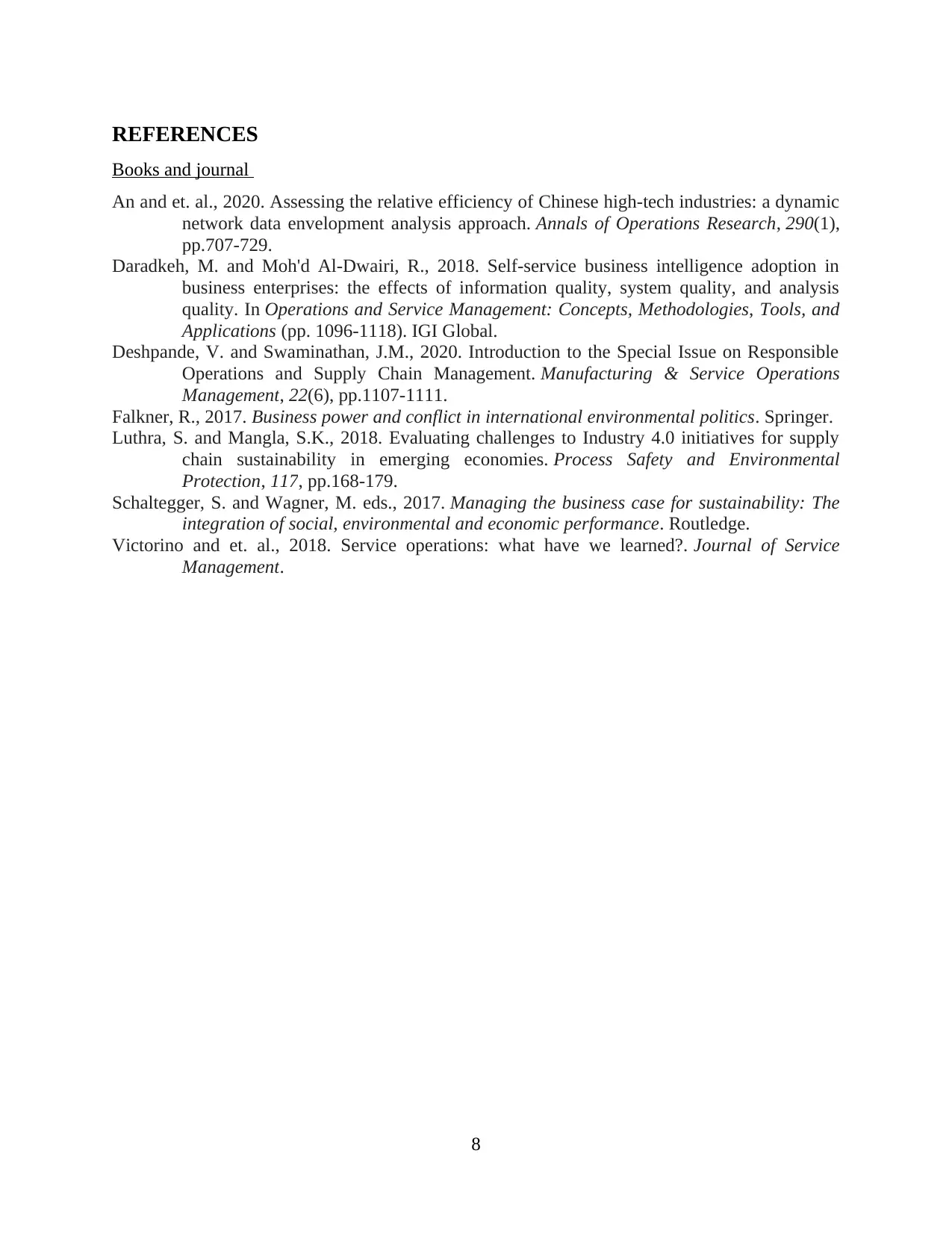
REFERENCES
Books and journal
An and et. al., 2020. Assessing the relative efficiency of Chinese high-tech industries: a dynamic
network data envelopment analysis approach. Annals of Operations Research, 290(1),
pp.707-729.
Daradkeh, M. and Moh'd Al-Dwairi, R., 2018. Self-service business intelligence adoption in
business enterprises: the effects of information quality, system quality, and analysis
quality. In Operations and Service Management: Concepts, Methodologies, Tools, and
Applications (pp. 1096-1118). IGI Global.
Deshpande, V. and Swaminathan, J.M., 2020. Introduction to the Special Issue on Responsible
Operations and Supply Chain Management. Manufacturing & Service Operations
Management, 22(6), pp.1107-1111.
Falkner, R., 2017. Business power and conflict in international environmental politics. Springer.
Luthra, S. and Mangla, S.K., 2018. Evaluating challenges to Industry 4.0 initiatives for supply
chain sustainability in emerging economies. Process Safety and Environmental
Protection, 117, pp.168-179.
Schaltegger, S. and Wagner, M. eds., 2017. Managing the business case for sustainability: The
integration of social, environmental and economic performance. Routledge.
Victorino and et. al., 2018. Service operations: what have we learned?. Journal of Service
Management.
8
Books and journal
An and et. al., 2020. Assessing the relative efficiency of Chinese high-tech industries: a dynamic
network data envelopment analysis approach. Annals of Operations Research, 290(1),
pp.707-729.
Daradkeh, M. and Moh'd Al-Dwairi, R., 2018. Self-service business intelligence adoption in
business enterprises: the effects of information quality, system quality, and analysis
quality. In Operations and Service Management: Concepts, Methodologies, Tools, and
Applications (pp. 1096-1118). IGI Global.
Deshpande, V. and Swaminathan, J.M., 2020. Introduction to the Special Issue on Responsible
Operations and Supply Chain Management. Manufacturing & Service Operations
Management, 22(6), pp.1107-1111.
Falkner, R., 2017. Business power and conflict in international environmental politics. Springer.
Luthra, S. and Mangla, S.K., 2018. Evaluating challenges to Industry 4.0 initiatives for supply
chain sustainability in emerging economies. Process Safety and Environmental
Protection, 117, pp.168-179.
Schaltegger, S. and Wagner, M. eds., 2017. Managing the business case for sustainability: The
integration of social, environmental and economic performance. Routledge.
Victorino and et. al., 2018. Service operations: what have we learned?. Journal of Service
Management.
8
1 out of 10
Related Documents
Your All-in-One AI-Powered Toolkit for Academic Success.
+13062052269
info@desklib.com
Available 24*7 on WhatsApp / Email
![[object Object]](/_next/static/media/star-bottom.7253800d.svg)
Unlock your academic potential
Copyright © 2020–2025 A2Z Services. All Rights Reserved. Developed and managed by ZUCOL.





